#Chambersburg Pike
Photo

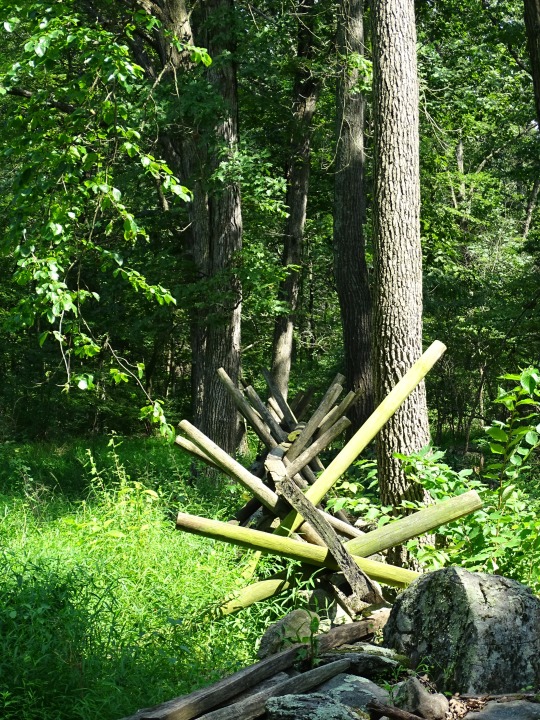

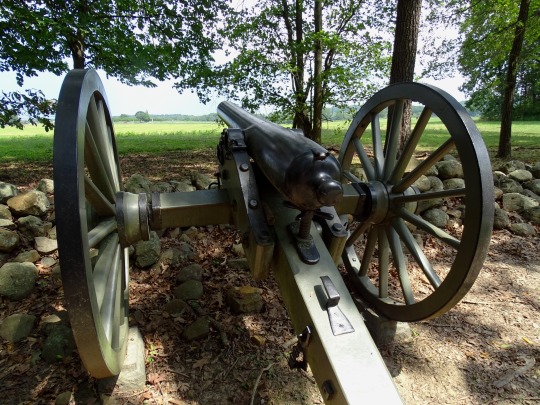
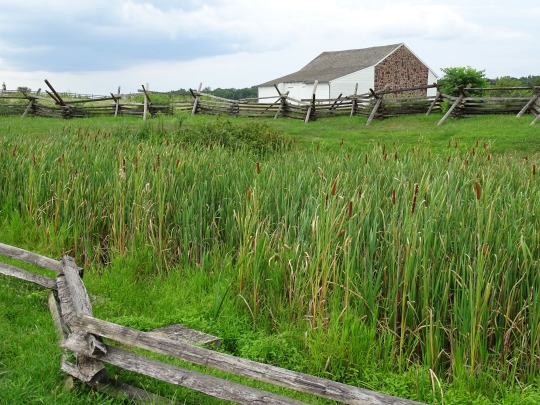


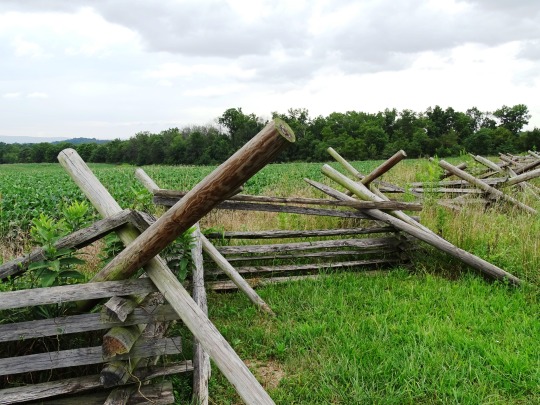

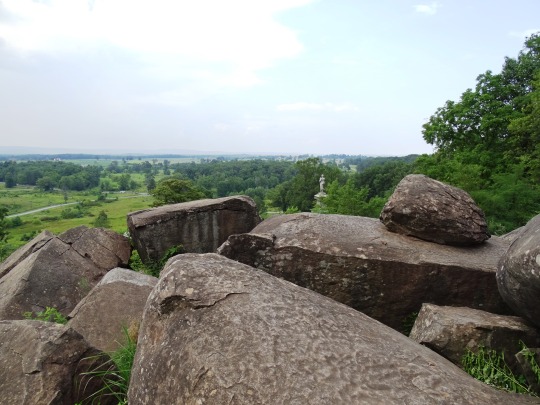
American Civil War: The final day of the Battle of Gettysburg culminated with Pickett's Charge on July 3, 1863.
#McPherson's barn#Devil's Den#Chambersburg Pike#Little Round Top#USA#Gettysburg National Military Park#Pennsylvania#travel#summer 2019#American Civil War#original photography#US Civil War#Battle of Gettysburg#final day#Pickett's Charge#3 July 1863#160th anniversary#US history#vacation#landscape#countryside#flora#nature#woods#cannon#landmark#free admission#tourist attraction
37 notes
·
View notes
Text

Battle of Gettysburg - Day 1
July 1
10:00 AM
I Corps Arrives at Gettysburg
"Forward, charge!" The Lieutenant Colonel ordered, and in response the 6th Wisconsin Volunteer Infantry Regiment lurched forward. "Align on the colors! Close up on that color! Close up on that color!" Their commander shouted, as the stragglers from the broken 95th New York and 14th Brooklyn Regiments joined them. In one strong mass, they moved across the field and charged towards the unfinished railroad cut, where Davis' Brigade took cover.
At 10:00 in the moring, just as Buford's cavalry were buckling under the pressure of Confederate attacks, the 1st Division of the Union I Corps arrived at Gettysburg. Moving quickly from the south of town, the division's 2nd Brigade was the first to arrive in the scene, quickly deploying at McPherson's ridge, north of the Chambersburg Pike. However, just as they were relieving the cavalry troopers deployed there, Davis' Confederate brigade moved up and struck them hard. Caught in the middle of deploying their forces, they were unprepared to receive the attack and were soon fighting a desperate battle, as some regiments began to retreat.
Meanwhile, south of the Chambersburg Pike, the 1st Brigade, of the 1st Division, of the I Corps began to deploy. They were the famous Iron Brigade. Wearing their unique black Hardee campaign hats, they were easily recognizable. Deploying in front of Herbst woods, they soon saw Archer's Confederate Brigade marching out of it.
Upon seeing the Iron Brigade waiting for them outside the woods, one soldier from Archer's brigade remarked: "“Here are those damned black-hat fellers again… ’Tain’t no militia – that’s the Army of the Potomac!"
The Iron Brigade let loose a volley of musket fire against Archer's brigade and soon the two were engaged in heavy fighting, as the 2nd Brigade continued to struggle agaisnt Davis' brigade.
Moving up to the front to assist in the fighting, I Corps commander, Major General John Reynolds, moved behind the Iron Brigade, urging them forward. However, as he was doing this, a stray shot struck him. He soon fell, dead, leaving I Corps leaderless.
Despite the loss of their commander, the Iron Brigade were pressing hard against Archer's Confederate brigade. Soon the brigade was charging the Confederates, forcing them to retreat. During their retreat, the Iron Birgade managed to capture a great number of prisoners, including Brigader General Archer himself.
However, the fight was far from over, because of the right the 2nd Brigade collapsed under the pressure of Davis' Confederate brigade, leaving their right flank exposed. Quickly, the Iron Brigade began to swing right to face the new threat, as the 6th Wisconsin Volunteer Infantry Regiment, which was held back by the Iron Birgade to act as a reserve, charged forward.
Struck by heavy musket fire, the regiments of Davis' brigade took cover in an unfinished railroad cut that ran parallel on the northern end of the Chambersburg Pike. However, while pinned in the cut, the troops of the 6th Wisconsin managed to outflank them and capture a good portion of the brigade.
By 12:00 noon most of the morning's fighting had subsided. There was now a lull, as fresh units from both sides began to arrive. For the Union, the rest of I Corps and XI Corps arrived to strengthen their defenses. For the Confederates, Pender's Division, of the Third Corps, arrived to join Heth's mauled division.
For the defense of Gettysburg, I Corps deployed on the west of town, while XI Corps moved north of town, ready to cover the roads there.
For two hours there was no fighting, aside from the occational artillery exchange from both sides. However, that would soon change, as another intense Confederate attack would strike, this time targeted at where I Corps and XI Corps met. Meanwhile, far to the north, a new force arrived, the Confederate Second Corps.
----------------------------------------
Featuring @whirlwindflux @flashmod and @a-spoonful-o-generosity as members of the famous Iron Brigade. All three wear the iconic black Hardee campaign hats, which was different from the blue forage cap worn by most Union troops.
#whirlwindflux#flashmod#a-spoonful-of-generosity#MLP#My Little Pony#Unicorn#Earth Pony#History#Gettysburg#Battle of Gettysburg#Gettysburg 160#Gettysburg 160th Anniversary
36 notes
·
View notes
Text

159 years ago today, June 30th, 1863, General Buford led his Cavalry into Gettysburg and deployed on the ridges west of town with the goal of delaying the impending attack on July 1st from Confederate Divisions approaching Gettysburg on the Chambersburg Pike. Buford had to hold the Confederates until General Reynolds arrived with the I Corps. Below is Mort Kunstler's print, "Rendezvous with Destiny", showing General Buford leading his troopers through the town of Gettysburg in front of the Adams County Court House. Below the print is a google view showing the similar scene as it appears today.
8 notes
·
View notes
Photo

Reynolds by Dale Gallon - Chambersburg Pike just west of Gettysburg on the morning of July 1, 1863, Major General John F. Reynolds instructs Captain James Hall of the 2nd Maine Light Artillery Regiment where to position his guns (x)
7 notes
·
View notes
Text
Tweeted
Gettysburg, PA, You Can’t Help But Cry A Sojourn to Gettysburg National Military Park: An Epic Clash of Ideals By Frank Hosek Traveling southbound through southeastern Pennsylvania on Chambersburg Pike, we passed by dormant farm fields that had https://t.co/wFXkyfutd1
— GoNOMAD.com Travel (@GoNOMAD) May 19, 2023
0 notes
Photo

This piece of artwork from 'The Battle of Gettysburg 1863 (1): The First Day' by Timothy J. Orr depicts the fight at the Edward McPherson Barn, 3.30 PM.
Confederate forces assailed the Union position at the Edward M. McPherson farm, a sixty-six acre plot along the Chambersburg Pike. Col. Roy Stone’s brigade (the 2nd Brigade, 3rd Division, 1st Corps)—popularly known as the Pennsylvania Bucktails—defended this sector. Two regiments— the 143rd and 149th Pennsylvania—stood behind a rail fence line on the south side of the pike, facing north. Stone’s third regiment—the 150th Pennsylvania—faced west, perpendicular to the pike. Shortly after the Confederates began their advance, Col. Stone suffered gunshot wounds to his arm and hip. As helpful soldiers dragged him to cover, Col. Langhorne Wister assumed command of the brigade.
59 notes
·
View notes
Photo

Headquarters of Robert E. Lee; Gettysburg, PA July 1863
“[It was] running the gauntlet in the strict sense of the word. The bullets were flying from each side in a perfect shower. The air seemed so filled that it seemed almost impossible to breathe without inhaling them. Some one fell beside me almost every step,” - Lt. Wilbur Judd, 97th NY
In 1863, the building known today as “General Lee's Headquarters” at Gettysburg, Pa. shot to fame after Matthew Brady’s photograph of it appeared in Harper’s Weekly. The stone home of 69-year-old (Widow) Mary Thompson was located between four key landmarks of the first day of fighting; Seminary Ridge, Oak Ridge, the Chambersburg Pike and the unfinished railroad the locals used as an alternate roadway to avoid paying the toll. If the walls could tell tales, the bloody fighting in the vicinity could be the photo caption, not the gathering place of Confederate generals.
On July 1st, at 7:30 a.m., the Battle of Gettysburg began. By 3:30 p.m., the entire Union position began to crumble. To support the infantry, artillery was placed on the ridge. “Just a few yards west of the Widow Thompson's house were the six Napoleons of Battery B, 4th United States Artillery under the direction of Lt. James Stewart. Three of the guns, under the command of Lt. James Davison, were positioned between the Chambersburg Pike and the railroad cut. The other three were positioned north of the cut in front of the Railroad Woods, and were commanded by Lt. Stewart himself. Just south of these and across the pike from the stone house were the two three-inch rifles of Lt. Benjamin W. Wilber's section of Battery L, 1st NY Light Artillery. South of these guns were the six Napoleons of Cpt. Greenlief T. Stevens' 5th ME Battery, and three three-inch rifles of Cpt. James Cooper' s Battery B, 1st PA Light Artillery.”
As the U.S. Army retreated towards the protection of the artillery, the Confederates followed, “yelling like demons, in a mad charge for our guns. … Almost at the same moment, as if every lanyard was pulled by the same hand, this line of artillery opened, and Seminary Ridge blazed with a solid sheet of flame, and the missiles of death that swept its western slopes no human beings could endure…. After we had ceased firing and the smoke of battle had lifted, we looked again, but the charging Confederates were not there. Only the dead and dying remained on the bloody slopes of Seminary Ridge,” wrote Corporal Robert Beecham of the 2nd WI.
Still, the rebel line continued to move forward. Ordered to retreat, Lt. Col. Rufus Dawes of the 6th WI realized that, “If we had desired to attack [C.S. Gen. Richard] Ewell's twenty thousand men with our two hundred, we could not have moved more directly toward them. We knew nothing about a Cemetery Hill. We could see only that the on-coming lines of the enemy were encircling us in a horseshoe.”
The men fought to move the artillery. Stewart relates how the pintle hook broke on a third piece. “As this happened, a party of rebels came running out of the timber adjoining, shouting: ‘Halt that piece!’ We were all completely surprised, but one of the men was fully equal to the occasion, and shouted back: ‘Don't you see that the piece is halted?’ … During all this time the enemy were firing upon us at not more than one hundred yards; and just as we got the gun out of the [railroad] cut, the enemy made a dash, this time getting within fifty or sixty yards, killing one driver and seriously wounding the wheel driver and two horses, which again caused delay. Seeing his predicament, the 88th PA "made a determined stand to save Stewart's Battery.”
Stewart rode back to check on Davison’s guns. The enemy, spotting him “shouted, ‘Surrender!’ but as I had not gone there for that purpose, I wheeled my horse and started him off as fast as he could go. … I started across the field, when the first thing I observed in front of me was a high fence, and as I could not go either to the right or left without being made a prisoner, I headed my horse for it, and he took the leap in splendid style. As he was making the jump I was struck on the thigh with a piece of shell. The shock was terrible, and I thought at first my leg was broken, but after feeling it I found the bone all right.”
Others were not as fortunate. Noticing that the fleeing Union Army was using the railroad cut as an escape route, C.S. Gen. Stephen Ramseur ordered a battery to throw shells into the cut. The fleeing men had to choose between surrender or “running the gauntlet”.
As his men chased the Federals through the town, C.S. Gen. Robert E. Lee arrived at the Thompson house on his “well-bred iron gray, Traveler”. Selected as Lee’s Headquarters, four guards were placed around the house and “half dozen tents” were set up near the house. The stone building, now within his lines, offered an elevated position with a view of the enemy that could be seen with a field glass. Lee may not have realized it, but at the end of the First Day of the Battle of Gettysburg, his Army may have captured as many as 5,000 men.
Inside the house during the battle, the Widow Thompson with her daughter-in law Mary, huddled in the basement as the roar of combat engulfed her home. Previously, on June 30th, Mary gave birth to her second child, Jane Meade Thompson. Furthermore, the wounded who could, made their way to any building seeking help. Her neighbor, Catherine Foster recounts:
“[Thompson’s] house and lot were filled with wounded and dying during the first day; she remained to care for them, and had a daughter [Hannah] living at the foot of the hill, who baked up a barrel of flour into bread, which she carried up the hill to the wounded, and refused to cease doing so during the three days...until her clothes were perforated with bullets and yet she would not be dissuaded, said, ‘In God is my trust.’ All her clothes and bedding except those on her person were used in dressing the wounded and her carpets in wrapping the dead for burial. An empty stone house and fenceless yard were all that was left the widow of seventy years.”
Throughout the next few days, the house was a beehive of activity as incoming messages came for Lee and his generals and artillery was moved into position nearby. Worse, the firing of the guns before Pickett’s Charge sounded, "it seemed as if the heavens and earth were crashing together."
After the Battle, Lee’s Army crossed back over the Potomac River and the Union Army followed. Negative rumors of Lee’s personal conduct began to swirl. To get to the truth, Dr. Junkin of the Sunday School Times went to interview Thompson. The interview appeared in the Lutheran and Missionary, a Philadelphia newspaper on September 24, 1863. Thompson stated that, “she never heard any profane or improper language from him [Lee]. General [J.E.B.] Stuart was with him part of the time. The impression which she had of him was not favorable, Stuart wanted to enter Gettysburg, and burn and make an indiscriminate plunder of all property, but to this Gen. Lee would not consent. She thought Stuart was a bad man: but Lee expressed himself and acted like a humane man showing much feeling on account of the sufferings and the horrors of War.”
#battle of gettysburg#civil war photo#history in color#civil war in color#color civil war photo#General Lee's Headquarters#gen ewell#gen ramseur#women civil war#history in full color
3 notes
·
View notes
Photo

Located on old Route 30 in Ortanna, the former Chambersburg Pike, was a tavern from 1795 until approximately 1872. When the Confederate army invaded Pennsylvania in 1862, they visited this tavern, and then again in 1863, as a portion of the Confederate army marched east, on their way to Gettysburg. (at Orrtanna, Pennsylvania) https://www.instagram.com/p/CS4YJ9BskLn/?utm_medium=tumblr
0 notes
Photo

When we stopped at @gettysburgnps in #Pennsylvania, we also checked out the newly restored General Lee’s Headquarters site, located on the Chambersburg Pike. This four acre site includes a small stone house which, at the time of the battle, was the home of 69-year-old widow Mary Thompson. The property surrounding the house played an important role in the fighting on July 1, 1863 and was a key position in the Confederate line for the rest of the #battle. After the battle, the Thompson house and adjacent property became a popular attraction, then host to a museum and motel complex. In 2014, the Civil War Trust announced plans to purchase and restore the property as much as possible to its 1863 appearance. The home was restored and the landscape returned to its #CivilWar appearance, which included removing the hotel and other modern amenities that had been built on the site. Interpretive markers were installed and a trail was built. The site opened to the public on October 28, 2016. There are plans to eventually donate the property to the @nationalparkservice. #pa #pahistory #pennsylvania #SpreadTheHistory #historygirl #americanhistory #travelblog #travelblogger #explore #blog #blogger #explorepennsylvania #FindYourPark #optoutside #gettysburg #gettysburgpa #nationalmilitarypark #battlefield #generalleeheadquarters #civilwartrust #archi_ologie #oldhouselove #architecture (at General Robert E Lee Headquaters)
#blogger#battlefield#civilwartrust#explorepennsylvania#archi_ologie#travelblog#oldhouselove#blog#civilwar#architecture#explore#findyourpark#pennsylvania#pa#optoutside#gettysburgpa#spreadthehistory#battle#nationalmilitarypark#pahistory#gettysburg#travelblogger#americanhistory#generalleeheadquarters#historygirl
1 note
·
View note
Text
General Robert E. Lee’s Headquarters at Gettysburg
July 1-3, 1863

The Battle of Gettysburg was 1 of the bloodiest battles in all of the Civil War. Here are some interesting things to know about the Commander General Lee and the Headquarters…
#1: During the Battle of Gettysburg, both Union & Confederate Commanders made their headquarters at the homes of widows.
Gen. George Meade made his headquarters at the home of Lydia Leister, a widow with six children. As the soldiers approached, Lydia left her home, returning after the battle to find her house severely damaged from iron and lead, and her yard dotted with dead horses.
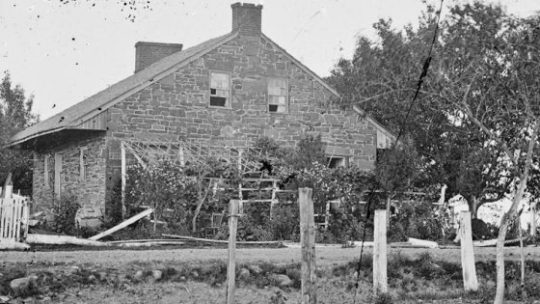
General Lee made his headquarters at a stone house on Seminary Ridge along the Chambersburg Pike occupied by a 70 year-old widow, Mary Thompson. Mrs. Thompson remained in her home throughout the battle, despite its proximity to intense fighting.
#2: On the 1st day of the battle some of the heaviest fighting took place around the Thompson house.
Federal soldiers who retreated from McPherson’s Ridge on July 1 fell back to a new position on Seminary Ridge. The Union line crossed the Thompson property and extended to the north and south. Union artillery under Lieut. James Stewart was placed in front of the Thompson House, supported by three regiments of Pennsylvanians.
A private from the 143rd Pennsylvania recalled that their regiment formed by the fence “at the old stone house.” Stewart’s artillery hit five regiments of Alfred Scales’ North Carolina Brigade, and with close range canister fire, repulsing the Tarheels for the first time in the brigade’s history, reducing one regiment from 180 men to only 30.
#3: The Union retreat from the Thompson House on Seminary Ridge resulted in the largest capture of Federal soldiers at Gettysburg.
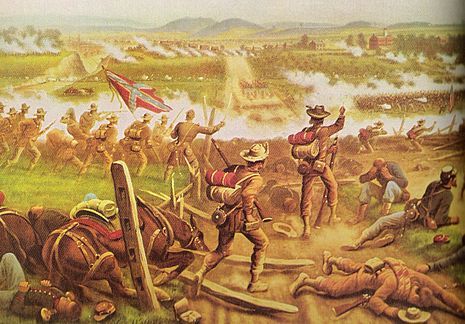
Although the Union center held against Scales’ brigade, the elements of Rodes’ and Pender’s divisions had crumbled the flanks of the Union First Corps. Col. Abner Perrin’s brigade then crashed through the heavy Union artillery fire into the center of the line and forced the Union First Corps to retreat. The position around the Thompson House was the last that Union troops held north of town on July 1.
In the midst of the retreat, many ran down the railroad cut that ran near the Thompson House, an act which proved disastrous when their escape route was cut off by the victorious divisions of Pender and Rodes. Of the 28 infantry regiments of the First Corps 24 of them had 50 or more men captured, for a total of about 2,000 men.
#4: The Thompson House’s location near the center of Robert E. Lee’s battle line made it the ideal location for his headquarters.
When Gen. Lee arrived at Seminary Ridge on July 1st, his army had routed the Union forces, and he immediately established his headquarters at the Thompson House. Four guards were placed around the house, and Lee’s staff members and officers made their camps nearby. Lee took his meals in the Thompson House and even slept there on July 1.
Due to the intensity of the battles on July 2 and 3, Lee spent little time at his official headquarters, yet the tents of his headquarters staff remained there and all incoming messages for Gen. Lee were sent to the Thompson House.
#5: The Thompson House served as a hospital for soldiers on both sides.
In the aftermath of the first day’s fighting at Gettysburg, dead and wounded men littered the fields around Seminary Ridge. The proximity of Mary Thompson’s house to the heaviest fighting of the day meant that wounded men, from both sides, were taken to her house. Mary remained at home throughout the battle and cared for the wounded men, using all her clothes and bedding as dressing for the wounded, and wrapping the dead in carpets.
#6: The area around Gen. Lee’s Headquarters was an important Confederate artillery position on July 2 and 3, 1863.

Owing to its central location, Confederate artillerymen found the ridges near Lee’s headquarters to be an admirable artillery position. Early on July 2, two Confederate batteries under Capt. Willis J. Dance were placed near the Thompson House along Seminary Ridge, where they were joined by Capt. Benjamin H. Smith’s Battery of three-inch rifles. Gen. Junius Daniel’s North Carolina brigade supported these guns, which opened fire on Union batteries at 4 o’clock and continued the bombardment until dark.
On July 3, the area around the Thompson House was once again a center of activity as Watson and Smith’s batteries were taken from their positions and moved south down Hagerstown Road to support the grand Confederate charge that afternoon.
#7: Lee’s Headquarters has a long and controversial history, continuing long after the Battle of Gettysburg.
After the Battle of Gettysburg, thousands of visitors poured into the town, many eager to see the small house where Gen. Lee had made his headquarters. Mary may have been uncomfortable with her newfound prominence; she left Gettysburg for a short period after the battle, but lived in the house until her death in 1873.
In 1896, a fire consumed the inside of the home but left the outside intact. In 1907, the longtime tenant of the home, Emma Feister, was arrested for “keeping a bawdy house.” During this time, articles began appearing in newspapers that challenged the well accepted fact that Lee had made his headquarters at the Thompson House. The most serious allegation came in 1907.
Henry S. Moyer published an article stating that in the spring of 1874, a year after Mary Thompson’s death, he interviewed a woman residing in the Thompson House who stated that Gen. Lee had never been present there.
Moyer’s most substantial evidence comes from a source he calls “a good friend,” who claimed that while speaking with Gettysburg historian, John Bachelder, Bachelder revealed that he had interviewed Lee, who stated that his headquarters were located in an apple orchard. The only evidence that this interview between Lee and Bachelder ever took place, however, comes from Henry Moyer’s 1907 article.
#8: The widow Mary Thompson’s house was owned by the Radical Republican Pennsylvania Representative Thaddeus Stevens.
In 1833, Michael Clarkson, an enterprising Gettysburg businessman, purchased a tract of land along the Chambersburg Pike and built the stone house that 30 years later would become the headquarters of Gen. Robert E. Lee. Clarkson was a prominent figure in Gettysburg, and a close friend of Thaddeus Stevens, a significant player in early Gettysburg industry and politics. Joshua Thompson, his wife Mary, and their eight children became tenants of the stone house.
Joshua was a habitual drunk who left Gettysburg and died sometime before 1850, leaving Mary to raise their children. When Clarkson ran into financial trouble and his properties were put up for auction in 1846, Stevens acquired the house in which Mary Thompson lived . It remained in his possession until his death in 1868. Stevens had made a contract with Joshua Thompson before he died, and he purchased the house to ensure the welfare of Mary and her children.
#9: Lee’s Headquarters marker on the Gettysburg Battlefield is almost certainly in the wrong place.
After Henry Moyer published his article in 1907, some historians chose to believe Moyer’s description of Lee’s headquarters, ignoring the numerous accounts, such as written accounts from Lee’s staff members and Gettysburg residents, that name the Thompson House as Lee’s official headquarters.
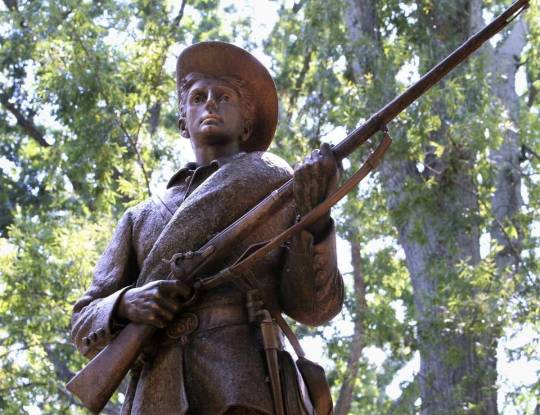
In 1919, the Gettysburg National Park Commission erected a marker that placed Lee’s headquarters across the street from the Thompson House. Inscribed on the marker is a quote from the Moyer article: “‘My headquarters were in tents in an apple orchard back of the Seminary along the Chambersburg Pike.’-Robert E. Lee.”
This quote was fabricated by the War Department and was never actually spoken or written by Lee. Despite this marker’s falsification, the National Park Service’s position is that Lee’s headquarters were established in a small tent on the south of the Chambersburg Pike, along with his staff and aides.
#10: Lee’s Headquarters and the previously un-preserved acreage around it was saved in early 2015 by the Civil War Trust
Even though the house has been consistently referred to in first-hand accounts as Lee’s headquarters, and it was in the center of fierce fighting on July 1, the house was not purchased by the Gettysburg Battlefield Memorial Association, the War Department, or the National Park Service. It was converted into General Lee’s Headquarters Museum in 1921, and remained privately owned until 2015.

After completing the acquisition of the property in early 2015, the Civil War Trust undertook an effort to restore the landscape to reflect its appearance on July 1, 1863.
Where do you believe General Robert E. Lee’s Headquarters REALLY was? No matter whether it was IN this house or in an apple orchard… we know that many men fought & died on this land and should be honored and remembered for their ultimate sacrifice.
Brought to you by UltimateFlags.com We love sharing stories about the Civil War to honor and remember those brave individuals for fought honorably and stood against tyranny.
Source
General Robert E. Lee Headquarters Flag

Buy the General Robert E. Lee Headquarters Flag Available Here!
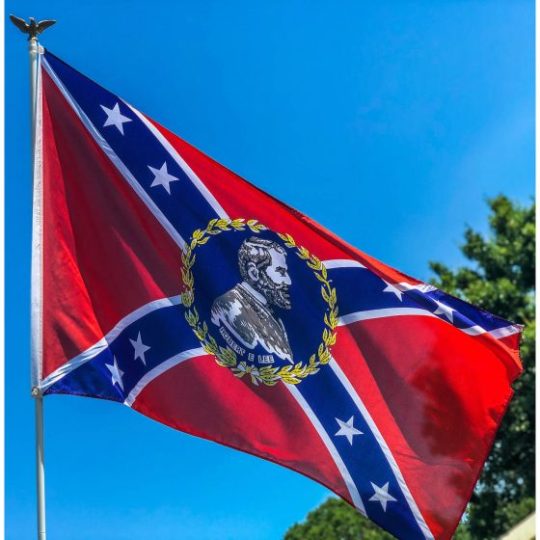
Rebel General Robert E. Lee Flag Available – Click Here!

Lee Headquarters Outdoor Nylon Embroidered Flag – Available Here!
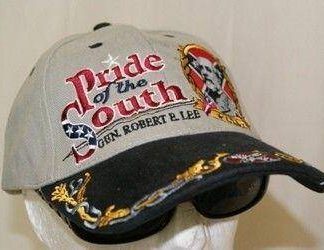
Buy Robert E. Lee Pride of the South Cap / Hat
Available Here!
The post General Robert E. Lee’s Headquarters at Gettysburg appeared first on Honoring Our Confederate Heritage & Virtues.
0 notes
Photo


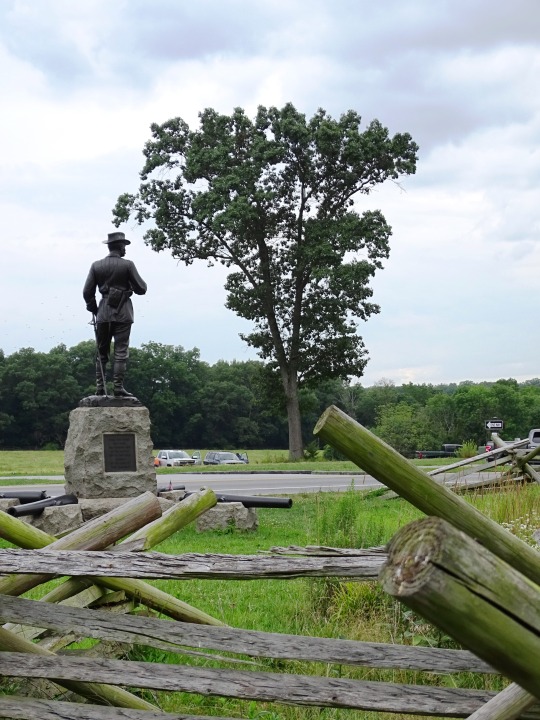

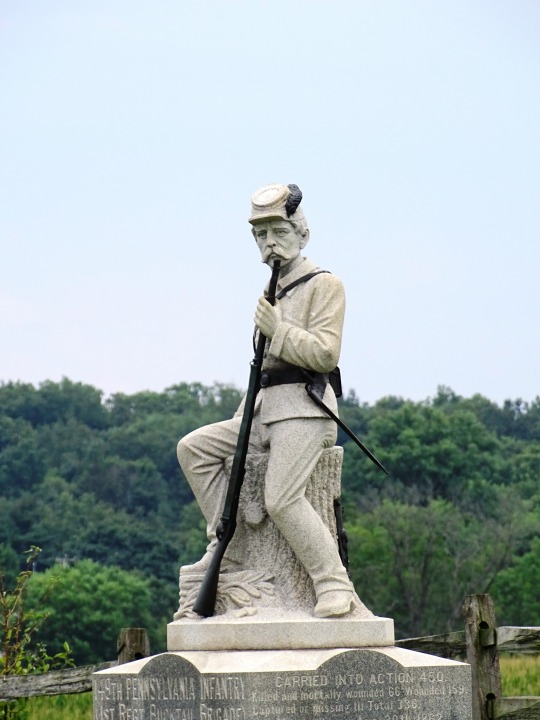



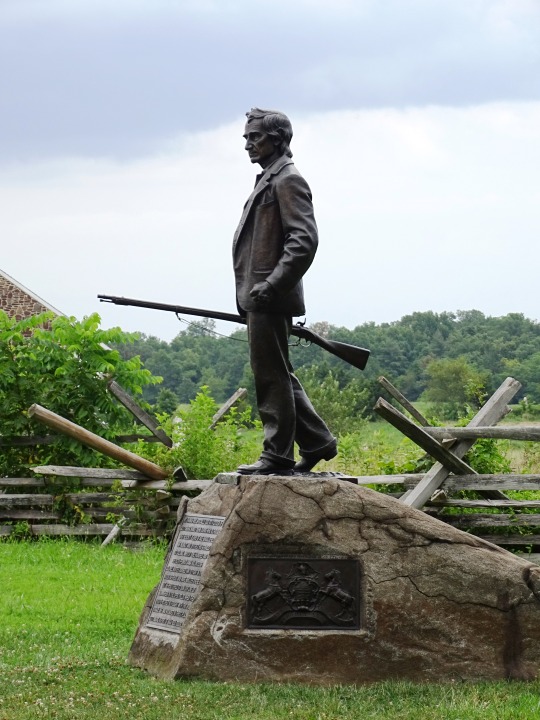

Gettysburg National Military Park (No. 52)
Edward McPherson’s farm was a half mile west of Gettysburg, atop the ridge that also bears his name. The area was the scene of intense fighting on July 1st, 1863, as Confederate General Henry Heth’s Division advanced towards Gettysburg against defending Union cavalry under General John Buford. Union reinforcements from General John Reynolds’ First Corps arrived and counterattacked, and fighting swirled through McPherson’s pasturelands and two fields planted in corn and wheat, as well as through neighbor John Herbst’s woods. McPherson’s barn became a place of refuge for the wounded, and continued as a hospital long after the battle ended.
McPherson was a lawyer and journalist who had served in the U.S. House of Respresentatives from 1859 until March of 1863. A Radical Republican, he had lost the1862 election, after which President Lincoln appointed him as Deputy Commissioner of Internal Revenue, and was living in Washington at the time of the battle.
John Slentz and his family were renting the McPherson farm. They were ordered out as the fighting on the ridge intensified, and took refuge in the town. They returned to find the house ransacked and in use as a hospital, and lived in the nearby Seminary for the next three months while the farm was made livable.
The house burned in 1895. The barn is the last survivor of Edward McPherson’s buildings, restored by the National Park Service in 1978. It is currently used by a local farmer who also leases the McPherson fields.
Source
#Edward McPherson’s farm#McPherson’s barn#Pennsylvania#tourist attraction#Gettysburg National Military Park#American Civil War#US Civil War#travel#architecture#Chambersburg Pike#McPherson Ridge#lantern#lamp#USA#US history#149th Pennsylvania Volunteer Infantry Regiment#John L. Burns#Albert Bureau#Cattail#landscape#countryside#summer 2019#vacation#original photography
2 notes
·
View notes
Text
Herbruck's celebrates Franklin County <b>warehouse</b> in anticipation of new egg-producing facility
CHAMBERSBURG, Pa. — Herbruck's Poultry Ranch has not yet started construction of its nearly $100 million egg-producing facility in Montgomery Township, Pa., but it is already storing and shipping eggs from a former warehouse in Greene Township, Pa. For now, the cold-storage plant on Sunset Pike ...
from Google Alert - warehouse storage https://ift.tt/2vo3oOd
0 notes
Text
Tweeted
Gettysburg, PA, You Can’t Help But Cry A Sojourn to Gettysburg National Military Park: An Epic Clash of Ideals By Frank Hosek Traveling southbound through southeastern Pennsylvania on Chambersburg Pike, we passed by dormant farm fields that had https://t.co/wFXkyfutd1
— GoNOMAD.com Travel (@GoNOMAD) May 12, 2023
0 notes
Photo

"El Primer disparo en Gettysburg. Artista Keith Rocco. El primer disparo en el amanecer del día 1 de julio de 1863 en Gettysburg a lo largo de Knoxlyn Ridge en las afueras de la ciudad de Gettysburg. Mirando detenidamente en la penumbra que disminuye, se encuentra un piquete de la Unión del Ejército del Potomac. En algún lugar en la distancia, mientras miraban hacia el oeste por el Chambersburg Pike de la granja Wisler, el piquete de la Compañía E del 8º de Caballería de Voluntarios de Illinois, asignado a la brigada del Coronel William Gamble, observó una creciente nube de polvo en la dirección de Cashtown. Los jinetes se habían desplegado en una delgada línea a unos cuatro kilometros de la ciudad, con puestos avanzados a 300 metros, desde donde se podía pasar por alto el puente de cruce de Marsh Creek, a 700 metros de distancia. El cabo Levi Shafer mandaba estos puestos avanzados, cuyos hombres habían realizado la guardia nocturna. El soldado Thomas B. Kelly y James O. Hale, observan estrechamente la actividad en la distancia, estaban seguro de su significado, y enviaron un mensaje para Shafer. "Podemos distinguir una columna de infantería confederada con gran detalle," Kelly escribió más tarde: " en un instante supe que tipo de trabajo se nos presentaba por delante". Kelly galopó de nuevo a la retaguardia para dar la alerta al campamento. Kelly encontró al primer teniente Marcellus E. Jones, en el puesto de guardia. Su caballo ya ensillado, Jones ordenó a su reserva marchar hacia adelante, envió un mensaje a su jefe en el Seminario Luterano, y acompañado de su corneta, ordeno a la avanzada a evaluar la situación. Bien sabía que el ejército de Virginia del norte del general confederado Robert E. Lee de Virginia del Norte estaba por ahí en alguna parte. La caballería federal había tenido escaramuzas con el enemigo durante varios días. Como el teniente Jones observó las figuras en la sombra de los hombres que marchaban hacia el puente de piedra de Marsh Creek, sabía que la batalla se libraría ese día. Los soldados vestidos de gris eran la avanzada de la Brigada de Tennessee de General de Brigada James Archer, de la División de Harry Heth, del Cuerpo de AP Hill, y no mostraban ninguna vacilación en su avance. Jones inmediatamente desmontó, lanzando las riendas a un lado para Hale. Los hombres estaban reunidos detrás de la tapia de una cerca, los caballos se ocultan. Jones escuchó a uno de sus hombres, George Sager, llamar a la advertencia, "aquí vienen." Como Sager se dispuso a disparar, Jones se lo impidió, alegando el derecho a tener el honor de abrir la batalla. Jones tomo prestada la carabina Sharp del Cabo Levi Shafer. El teniente apoyó el arma a lo largo de la baranda superior de la valla para mantenerla estable. Apuntó con cuidado a un oficial montado sobre un caballo blanco. Como los confederados comenzaron a cruzar el puente sobre Marsh Creek, Jones disparo. El tiro a una distancia extrema como es lógico, no dio en el blanco, pero el tiro de apertura de la batalla había sido disparado. Los confederados comenzaron a formar una línea de escaramuza para avanzar en la acción. Jones ordenó llevar los caballos a retaguardia y organizó una línea de escaramuza para resistir la embestida. En otros lugares del campo, en los puestos de piquetes también estaban empezando la escaramuza. Una controversia surgió después sobre quién disparó realmente el primer tiro de la batalla, con varios reclamando el "honor". Años más tarde, Jones, Shafer y otros volverían al campo de batalla y colocaron un marcador en el lugar donde se encontraban en las primeras horas de la mañana del 1 de julio. En el gran esquema de los acontecimientos, poco importaba quién disparó el primer tiro "la mayor batalla jamás librada en suelo norteamericano había comenzado. https://ift.tt/2IVRr7M https://ift.tt/2GweReL
0 notes
Text
Living Room Furniture Selection
As amongst the marquee franchises involving NFL, the Pittsburgh Steelers have a following during the nation. May be no surprise that Gambling tickets are hot commodities every football season.
During this happening the 13th Mass, 104th NY, 94th NY, 107th PA and 16th Me from Paul's Brigade was sent in bolster the union line. Gen Ramseur arrived with his brigade, 2nd NC, 4th NC, 14th NC and 30th NC regiments. The 16th Me was ordered to establish a suicidal counterattack to give time for your other units to pull out. They advanced towards the Mummasburg Rd, receiving 61 casualties killed or az congresswoman.
A: Reading the plaques on the Surfer's Walk of Fame on the Hermosa Beach Pier. There are a bunch short bios on each one of the inductees. The South Bay and Hermosa Beach in particular, is a mecca for surfing and surf tale. In the sixties, all the big boys had shops in Hermosa Beach: Greg Knoll, Dewey Webber, Rick Jacobs, Infinity..
Book up-front. The best advice is find out at least one restaurant you really would like to try before you're and make reservations immediately right after possible. A few of these restaurants, no matter how small, book up months too soon. Save at least one night for trying a restaurant you been aware of while having breakfast or shopping. And, of course, picnic car should be done.
Joseph Hoffman Cubis 2 or 3 Seater Sofa This model was originally innovation globe early 20th century, and comes in two basic sizes (two or three places). That would be fine in every space, such as a study or family house. This model within the living room furniture has become very popular for many decades.
With the retreat in the 1st and 11th Corps through city to Cemetery Hill, to view on facebook north of Chambersburg Pike came a good end. Despite the Confederates holding the field, it's difficult to state that day one was an union prevail over. The 1st Corps fought and held their ground against overwhelming odds, only retreating after being flanked and pushed to their limit. The 11th Corps was utilized an usually very hard position. Given their reputation some say they quit and ran, but had been looking out gunned and flanked. No soldier can endure the pressure put for them by the confederates.
John began having problems holding a work. One company after another would terminate him several point. Other men showed interest in Helen and that enraged the dog. Doctors couldn't pinpoint was was ailing Helen, but treatment wasn't a choice. The alcohol and pills aggravated her symptoms, and she or he didn't care. He still struggled to be a good provider for his young clan. Things were noticed that you go from bad to worse and John knew it.
That is the silver filling. The reality simple fact long after Obama will be gone, it can take decades to repair the economic destruction of his Marxist-socialist insanity in the same method it took Germany nearly 40 years to recover from the destruction of Hitler's madness. Are usually assuming this destruction is repairable to be able to a constitutional republic but we are not certain in.
0 notes
Photo
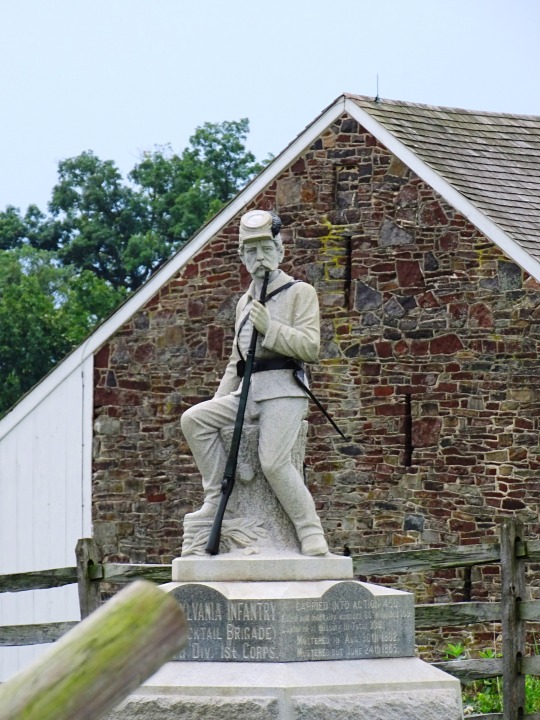
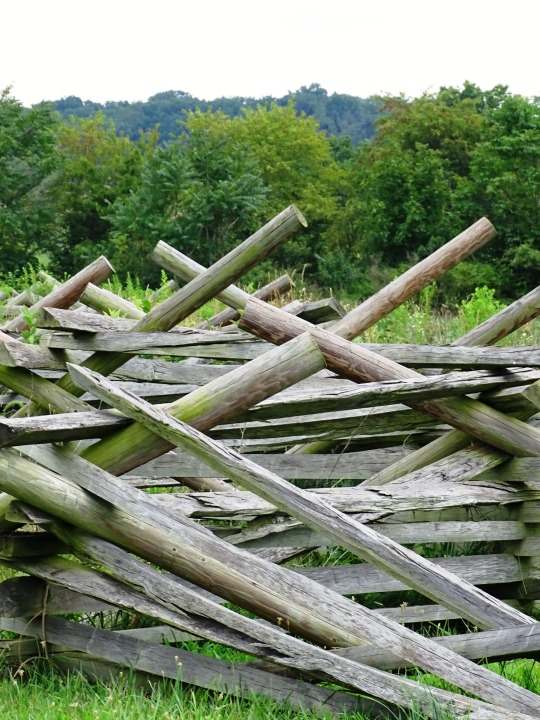
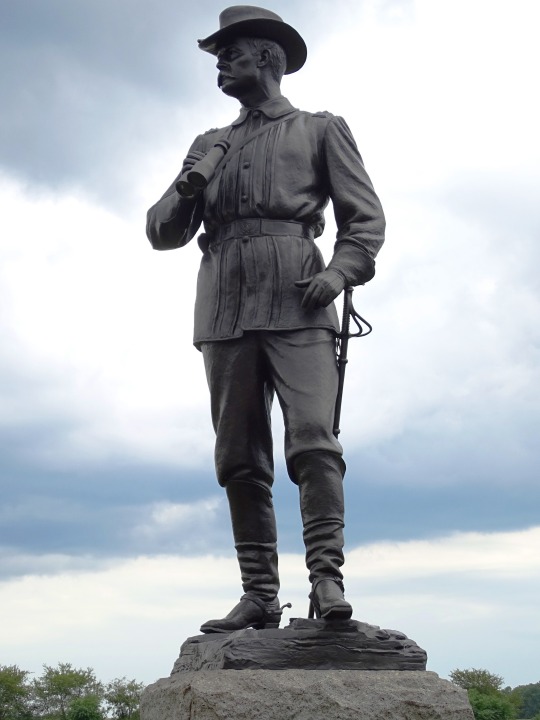
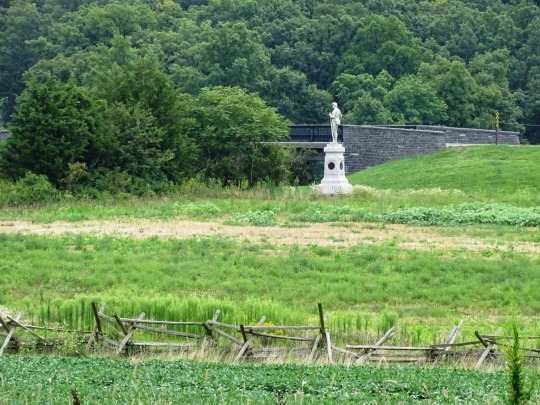




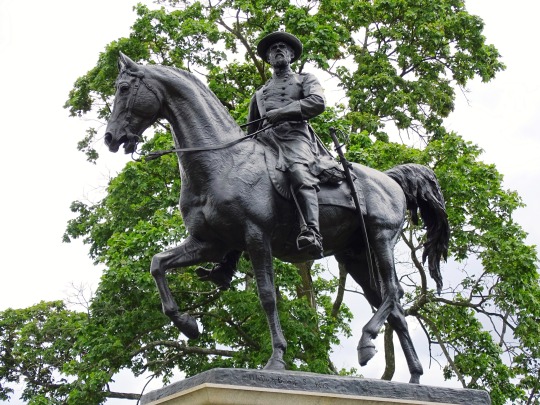
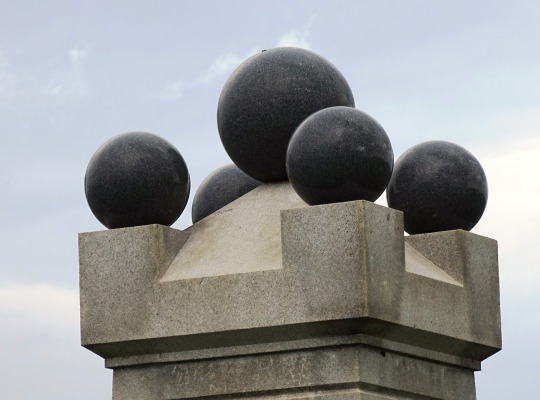
Gettysburg National Military Park (No. 51)
The monument to Union Brigadier General John Buford is west of Gettysburg on Chambersburg Road (U.S. 30).It was erected in 1892 and dedicated on July 1, 1895.
The nine foot tall bronze statue was created by sculptor James Kelly, who was well known for his statues of military figures. Kelly’s interviews with his subjects were published in 2005 in Generals in Bronze, edited by William B. Styple. The statue stands on a six and a half foot tall rough-hewn granite base.
The cannon surrounding the monument are the actual pieces of Calef’s Battery, 2nd United States Artillery, Battery A. The barrel facing down Chambersburg Pike (the one facing toward the lower right corner of the photograph) fired the first Union artillery shot of the battle under General Buford’s personal direction. Captain Calef tracked it down after the war using its serial number, 223. It is marked by a small bronze plate which can be seen in the photo on top of the barrel.
Source
There are three monuments to the 149th Pennsylvania Volunteer Infantry Regiment on the Gettysburg battlefield. The original monument was dedicated in 1886 on McPherson’s Ridge. In 1888 this was moved to its present location on Hancock Avenue, where the regiment was positioned on July 3.
When Pennsylvania made state funds available for monuments it was decided to erect a second monument to the 149th. The new, main monument replaced the original on Chambersburg Road near the McPherson barn, where the regiment fought on July 1. It was dedicated in 1888 by the State of Pennsylvania.
The 149th Pennsylvania was commanded at the Battle of Gettysburg by Lieutenant Colonel Walton Dwight. He was wounded on July 1. For some time that afternoon all of the regiment’s officers on the field were killed or wounded. Company D had been detached as Provost Guard, and when it rejoined the regiment in the late afternoon its Captain James Glenn took command of the regiment.
In the first day’s fighting along Chambersburg Pike the regiment suffered heavily from Confederate artillery. One shot killed three men, cutting Captain Alfred Sofiel in half. Lieutenant Colonel Dwight sent the color party fifty yards north to draw fire away from the regiment. This worked, although when the Union line was forced to retreat the colors were lost, in spite of the heroic death of Color Sergeant Henry Brehm, who was shot down after he had fought off a party of attackers and was running to return the colors to the retreating regiment.
Source
#Major-General John Buford#Gettysburg National Military Park#Pennsylvania#summer 2019#original photography#American Civil War#US Civil War#travel#vacation#landscape#countryside#tourist attraction#US history#public art#James Edward Kelly#Major-General John F. Reynolds#Chambersburg Pike#H. K. Bush-Brown#1st Regiment Bucktail Brigade#Hall's Battery#2nd Maine Artillery Monument#architecture#fence#forest#field
1 note
·
View note